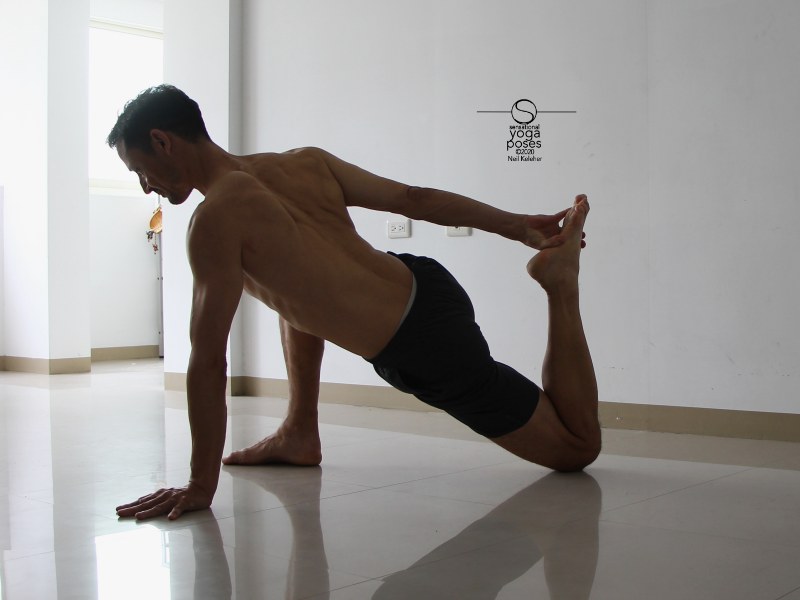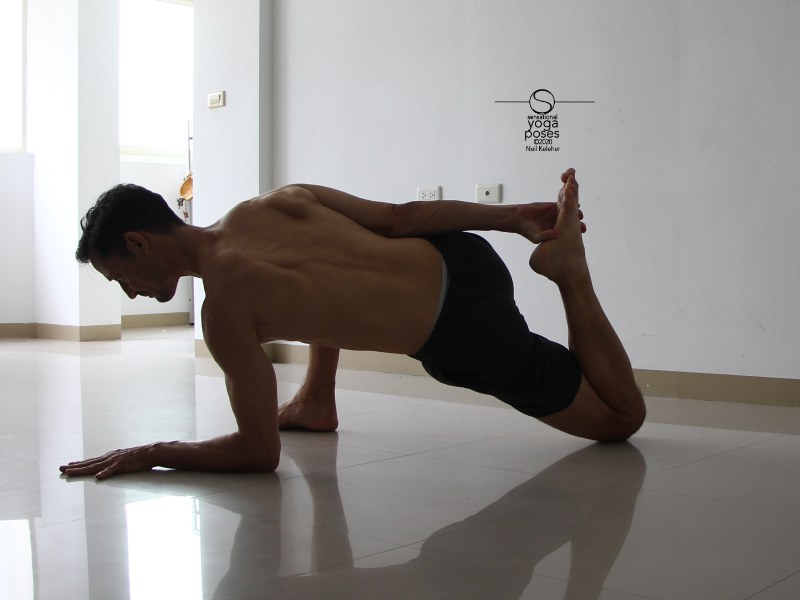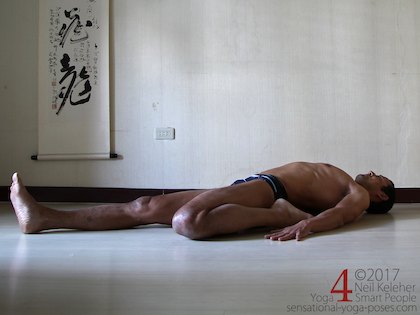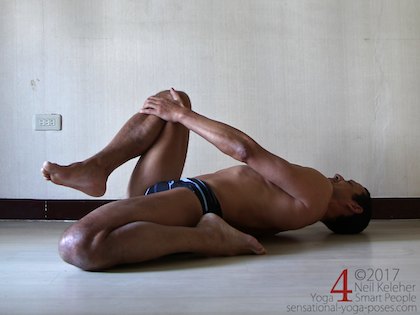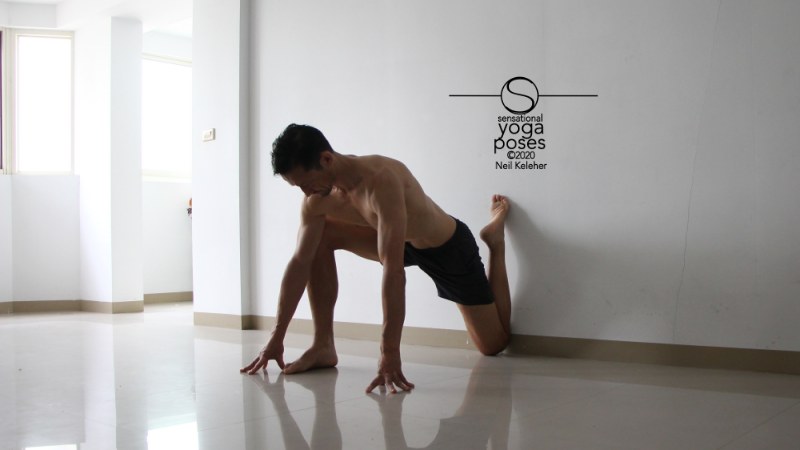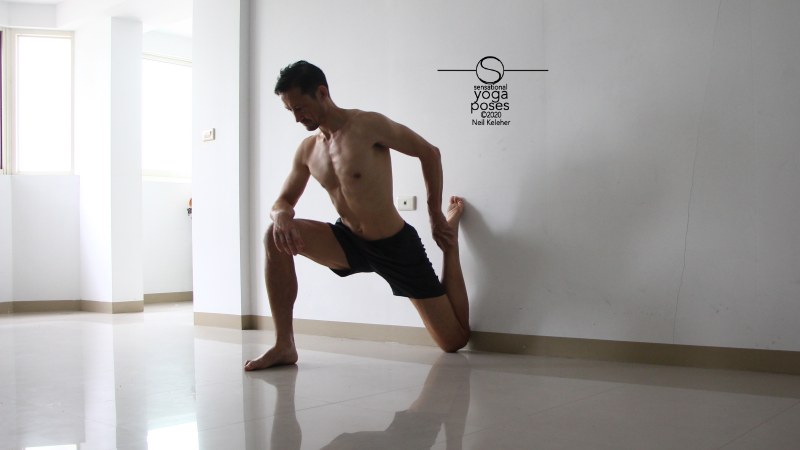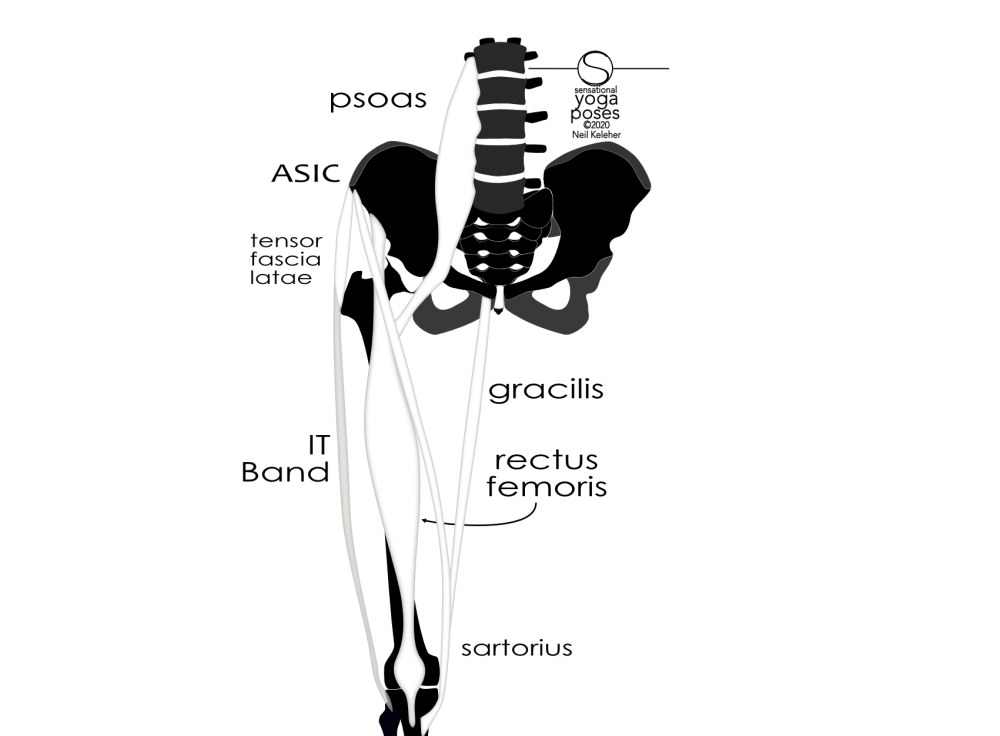Couch stretch and other stretches for the hip flexors
So the couch stretch may have gotten its name from Kelly Starret, possibly because you can do this stretch using a couch.
The Stephen Thomas Hip Stretch
I encountered a version of this stretch in a yoga class with a guy named Steven Thomas. This hip flexor stretch didn't involve a couch but was quite intense.
Now I'll get to the Starret stretch in a moment. But first, I'll talk about the hip flexor stretch I learned from Stephen Thomas (the "Steven Thomas Hip Flexor stretch""), plus some another hip flexor/quad stretch (which is similiar to the couch stretch but which I'll call the "Hip Flexor Wall Stretch" because you use a wall).
In the first variation of the Steven Thomas Hip flexor stretch, the idea is to go into a lunge and grab the back foot with the opposite hand. The free hand is placed on the floor. Focus on sinking the hips down. You'll probably feel the stretch most particularly in the front of the thigh of the back leg.
Personally, I thought that from here going down onto one elbow would be easier. It was actually even more uncomfortable. This was the second variation of the stretch.
Hip Flexor stretch using a wall
A similiar type of stretch (not quite the same as the couch stretch, but with the same foundation) was to position yourself with one knee at the base of a wall with the shin of that knee vertically against the wall. The foot of the other leg was forwards, as if in a lunge.
Generally, the first variation in this position is to push the hips back towards the wall. You can lean your torso forwards to make this easier. Once you get your hips close to the wall you can increase the stretch by then trying to lean your back against the wall.
This position is fairly similiar to reclining half hero quad stretch.
Reclining half hero quad stretch
In reclining half hero quad stretch the idea was to sit with one leg in a kneeling position with your butt on the floor inside the foot of the kneeling leg. From there you gradually lie back onto your elbows and then, if able, your back.
This can be fairly intense on the low back unless you activate your thigh and hip muscles. (To activate them, try "reaching" your knee away from your hip.)
You could then intensify the stretch (as if it wasn't already intense enough) by hugging the other knee to the chest or if you really like intensity, straightening the other leg while trying to bring it closer the the chest. (I've not included a picture of that stretch because I can't do it!)
These latter variations up the intensity for the kneeling leg because they when you flex the hip of the other leg, it causes the hip bones to tilt backwards. That increases stretch of the hip flexors of the kneeling leg.
The couch stretch
For the couch stretch, you start by placing one shin against a wall with the knee on the floor at the base of the wall. You then step the other foot forwards into a lunging position. If you hold this position the idea can be to simply sink the hips down.
Note that this position is fairly similiar to the Stephen Thomas hip flexor stretch. The main difference is that you aren't grabbing the foot. The back foot is instead supported by the wall.
Now with the Stephen Thomas stretch, because you are grabbing the foot with the opposite hand, when you sink your chest down closer to the floor the stretch intensifies, because you are increasing the knee bend at the same time.
To increase the hip flexor stretching intensity with couch stretch, you bring your torso more upright, ideally while continuing to sink you hips.
For myself when I do this, I like to prop my front leg forearm on the thigh. And initially I feel a bit more stable if I touch my back foot with the same side hand.
Why you should lift your chest when doing the couch stretch
Now there are a few "activations" that you can experiment with and that you may find makes it easier to sink the hips down (without having to wait quite so long). But prior to talking about that, one simple thing that you can do to make this stretch (and possibly quite a few other stretches) more effective is to lift your chest away from the fronts of your hip bones. The idea in doing this is to lengthen the front of your abdomen. This puts adds tension to the front of the abdomen which in turn tends to cause an upwards pull on the fronts of your hip bones, particularly your ASICs but also your pubic bone. And that's a good thing when stretching your hip flexors.
So which hip flexors does this couch stretch actually stretch?
Generally when talking about hip flexors the muscles that may come to a lot of people's minds are the psoas and illiacus. Other hip flexors include the tensor fascia latae, the sartorius and the rectus femoris. All three of these muscles attach at or near the ASICs, the pointy bone at the front of each hip bone. These three hip flexors also cross the knee joint.
- The tensor fascia latae attaches via the IT band to the outside of the tibia.
- The sartorius attaches to the inside of the tibia.
- The rectus femoris attaches to the knee cap (and from there to the front of the tibia.)
When the knee is kept straight (by the action of the quadriceps, generally) these hip flexors can be used to flex the hip or resist hip extension. If the knee is stabilized, they can also help to flex the hip when the knee is bent.
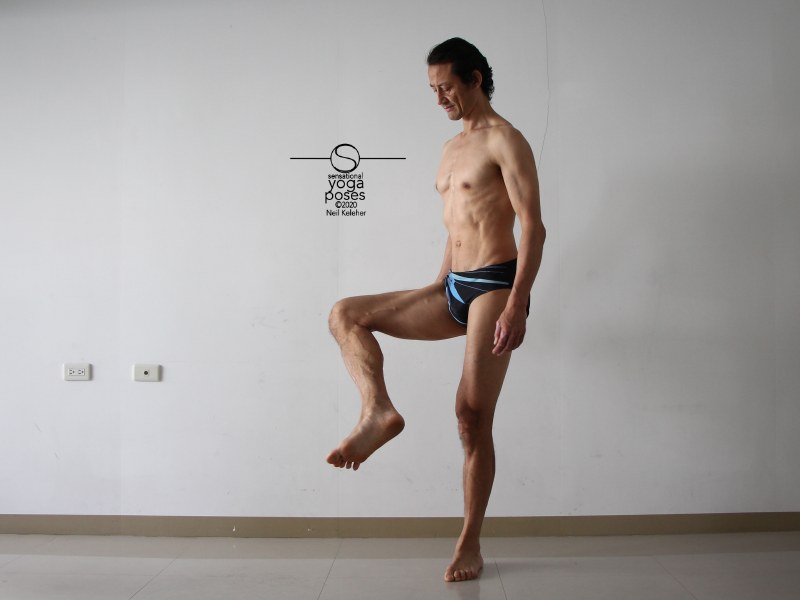
Here I'm using my sartorius to flex the lifted leg hip.
Muscles that rotate the shins
A key point is that when the knee is bent the lower leg bones can rotate relative to the femur. The tensor fascia latae can help to rotate the shin externally. Meanwhile, the sartorius can rotate the shin internally. Note that when the knee is straight and the torso is upright, the tensor fascia latae can act to rotate the leg internally.
There are other hip muscles that can activate to rotate the shins. Along the outside of the thigh the superficial fibers of the gluteus maximus attach via the IT band to the outside of the tibia. The biceps femoris (both the short head and the long head) attaches to the fibula, the bone that runs along the outside of the tibia. Meanwhile, running along the iner thigh, the gracilis and the semitendinosus, both attach along with the sartorius to the inside of the tibia. Semimembranosus, another hamstring muscle, may also help with shin rotation.
Note that all of these muscles attach to the inside or the outside of the lower leg. They also attach to the prominent corner points of the hip bone. These muscles can thus rotate the shin or stabilize it against rotation. They can also help move the hip bone, or stabilize it.
Why you might want to stabilize your shin against rotation when doing the couch stretch
In a couch stretch, in particular because you aren't grabbing the foot of the leg you are stretching, it's relatively easy to not think about stabilizing the shin against rotation. The stretch is so intense all you want to think about is getting it over with. But why is it so intense? One reason is that your brain may be resisting the stretch, turning muscles on to oppose the stretch because it isn't getting any muscle signaling to show it that the knee is stabilized against rotation. Why might your brain want rotational stability? So that your shin doesn't accidentally rotate past it's limits. If the usual leg rotators aren't doing their job then the brain uses whatever else is handy.
How to stabilize the shin against rotation when doing the couch stretch
In general, when doing anything with the body you need stability somewhere. Understanding that the shin can rotate when the knee is bent, one thing you can experiment with is stiffening the shin against rotation to see if it helps you in the couch stretch. Try to activate the inside and outside of the knee, or if you like, stiffen it or engage the muscles that act on it. Make it feel strong. If you can manage that, you may find that while the pose is still uncomfortable, the discomfort has lessened in intensity and you may have found that you can go deeper into the stretch.
What if you don't know how to make your knee feel strong? Or what if it didn't help?
Stabilizing the hip instead
While stabilizing the knee against rotation is one thing, the muscles that help to create that stability all attach, as mentioned, to corner points of the hip bone. And so another approach is to look at stabilizing the hip bone.
A simple way to do that is to activate the gluteus maximus of the leg that you are stretching.
Extending the hip with the gluteus maximus to help stretch the hip flexors
The gluteus maximus could be divided into two main parts. The deep part is a hip extensor. It can act to bend the hip joint backwards. Where the hip flexors bend the hip forwards, the hip extensors bend it backwards. You could try activating your gluteus maximus to actively bend your hip backwards. In the couch stretch this means using the gluteus maximus of the back leg (the leg you are stretching) to help sink your pelvis.
This is something that you can try in all variations of the couch stretch. With hands on the floor work at gradually activating your gluteus maximus. (If you like, and if you are able, you can try stabilizing your knee also. Notice the effect. Does it help or do the opposite? Act accordingly.)
Relax your glutes and then see if you lift your torso higher (try coming up onto your finger tips or if you have yoga blocks, use them instead.) Here again, activate your gluteus maximus. But, do it slowly and smoothly.
How the gluteus maximus can help stabilize your hip joint
Note that when you activate your gluteus maximus, opposing muscles, hip flexors like the psoas and iliacus may also activate. They do so to give the glutes a force to work against. In the process the hip joint (which includes the hip bone and femur) is stabilized. And that's something your brain can detect (because muscles have activated.) If it was inhibiting the stretch due to a perception of a lack of stability, stabilizing the hip joint by activating the gluteus maximus may help to switch of that inhibition. In other words, you may find that you can go deeper. You may still find the stretch extremely uncomfortable. But now at least you'll be uncomfortable while going deeper versus being uncomfortable while staying in the same place.
How the gluteus maximus can help stabilize the knee joint
As mentioned, the gluteus maximus can be divided into two parts. The superficial fibers of gluteus maximus attach, like the tensor fascia latae, to the IT band. From there they attach to the outside of the tibia. Activating the deeper gluteus may add tension to the IT band and the superficial fibers of the same muscle making it easier for them to activate. It's as if you've helped take out any slack. From there these muscles can act to try to externally rotate the shin. Internal rotators may then automatically activate to counter this tendency, thus stabilizing the shin.
How to increase the hip flexor stretch when doing couch stretch
Note that in the Stephen Thomas stretch, you could increase the stretch by going down onto one elbow and thus increasing the knee bend (among other things). You can achieve a similar affect in the couch stretch by doing it with your ankle flexed.
You'll probably have to go onto your hands to change your foot position but here again, try activating your glutes. You probably wont' want to thank me because it can be a sensation filled experience.
Which hip flexors are stretched in the couch stretch?
So what muscles are being stretched in the couch stretch and the Stephen Thomas hip flexor stretch?
Going back to the Stephen Thomas hip flexor stretch, when you grab the foot behind the back with the opposite hand, the tendency is for the fronts of the ribs on the back leg side to move away from the hip bone. This creates a pull on the ASICs of the back leg hip bone. It pulls the ASICs away from the knee which gives then stretch the hip flexors.
Going onto the elbow, you may find that the stretch increases because the ribs on the back leg side move further from the ASIC. (It's a sort of twisting action that increases the distance between ribs and ASICs, and that pulls the ASIC away from the knee, deepening the hip flexor stretch.
So which hip flexors are affected?
When the knee bends, the distance the sartorius crosses is shortened. (Thus the sartorius can also act as a knee flexor!) So whether you are doing the Stephen Thomas hip flexor stretch or the couch stretch, your sartorius probably isn't going to be affected (especially as it bends behind the knee before attaching to the tibia.)
With the tensor fascia latae, it's a bit more difficult to stay. I'd say that because of the way it runs to the top of the tibia, it tends not be work in creating knee flexion or extension. And so it may not be shortened that much when the knee is bent. As a result you may get some stretching of this muscle when doing the couch stretch or the Stephen Thomas hip flexor stretch.
Perhaps the hip flexor most affected by either of these two stretches is the rectus femoris. Running down the center of the front of the thigh, this muscle has no way of escaping the stretch. It's lengthened when the knee is bent, and it's further lengthened when you extend the hip.
Learn more about your hip flexors
To learn more about your hip flexors (like how to activate them and different ways to stretch them) check out my hip flexor muscle control course. You'll learn how to feel and control your hip flexors as well as options for anchoring them. Learn more about Hip flexor muscle control.
Published: 2020 05 20

